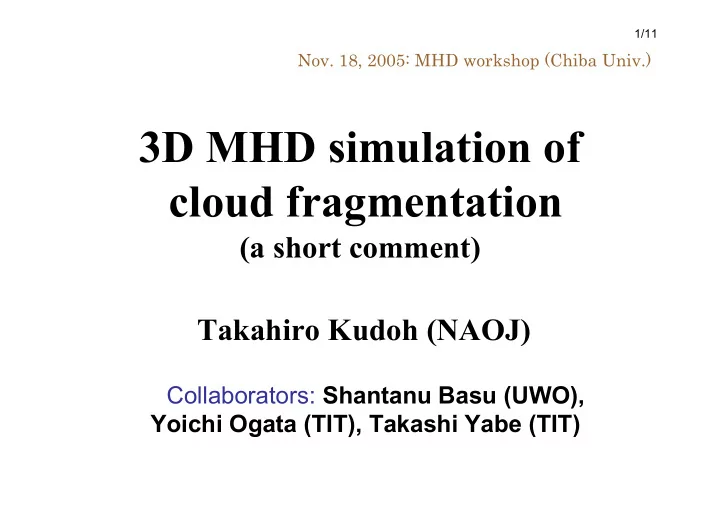

1/11 Nov. 18, 2005: MHD workshop (Chiba Univ.) 3D MHD simulation of cloud fragmentation (a short comment) Takahiro Kudoh (NAOJ) Collaborators: Shantanu Basu (UWO), Yoichi Ogata (TIT), Takashi Yabe (TIT)
2/11 Interstellar molecular clouds are the sites of star formation. Taurus (Nagoya 4m) radio ( 13 CO) Stars are forming at and . star ~10pc A simple model: They are self-gravitating gas clouds with magnetic field and turbulence.
3/11 Cloud contraction with magnetic field There is an evidence of large-scale magnetic fields in the cloud. Magnetic force prevent the gas moving across the magnetic field. gravity magnetic force The cloud is expected to be flat perpendicular to the magnetic field. The flat cloud is fragmented and gravity cores are formed in the cloud. magnetic force We are going to study this process.
4/11 Model: Gravitationally Stratified Cloud Most of the previous 3D MHD Magnetic field line simulations picks up the local region. Low density and hot gas Magnetic field z y X g Periodic boundary box; Uniform density Molecular cloud We pick up a gravitationally stratified flat cloud as an initial condition.
5/11 Gravitational instability of plate-shaped gas. - Weak magnetic field Nakano & Nakamura 1978 E E < (supercritical) mag grav gravitationally unstable 4 H ( B 0 ) � � � � most unstable - Strong magnetic field E E > (subcritical) mag grav gravitationally stable ambipolar diffusion (magnetic diffusion) gravitationally unstable (Mouschovias 1978)
6/11 2D-MHD simulation with ambipolar diffusion 2D approximation : Magnetic field line Structure of the z-direction is integrated into the plane. 2D simulation box Dense cloud Molecular cloud Basu & Ciolek (2004) Li & Nakamura (2004)
7/11 3D-MHD simulation with ambipolar diffusion (this study) Magnetic field line Low density and Low density and hot gas Magnetic field hot gas 3D dense sheet simulation z Molecular cloud box y 3D-MHD with ambipolar X diffusion Isothermal We input large random perturbation (V max =10C s ) perpendicular to magnetic field at t=0.
Density 8/11 top view slice Weak magnetic field Strong magnetic field (E mag <E grav ) (E mag >E grav ) Mass-to-flux ratio=2 Mass-to-flux ratio=0.7 ~2.5pc ~2.5pc side view slice
9/11 Weak magnetic field (E mag <E grav ) Strong magnetic field (E mag >E grav ) •Fast gravitational collapse •Slow gravitational collapse ~ 7 x10 5 year ~ 5 x10 6 year •Infall velocity is nearly •Infall velocity is subsonic. super-sonic. •V z is also subsonic. •V z is also nearly supersonic.
10/11 Weak magnetic field Strong magnetic field Magnetic flux density lower β higher β core core 0 . 6 B � � 0 . 3 B � � plasma β =P gas /P mag B � � 0.5 β const
11/11 Summary •Time scale of the gravitational collapse Fast collapse ~ 7 x10 5 year : E mag <E grav (supercritical) Slow collapse ~ 5 x10 6 year : E mag >E grav (subcritical) •Infall velocity supersonic: E mag <E grav (supercritical) subsonic: E mag >E grav (subcritical) •Magnetic flux ( lower beta cores) : E mag <E grav (supercritical) 0 . 6 B � � 0 . 3 (higher beta cores): E mag >E grav (subcritical) B � �
Recommend
More recommend